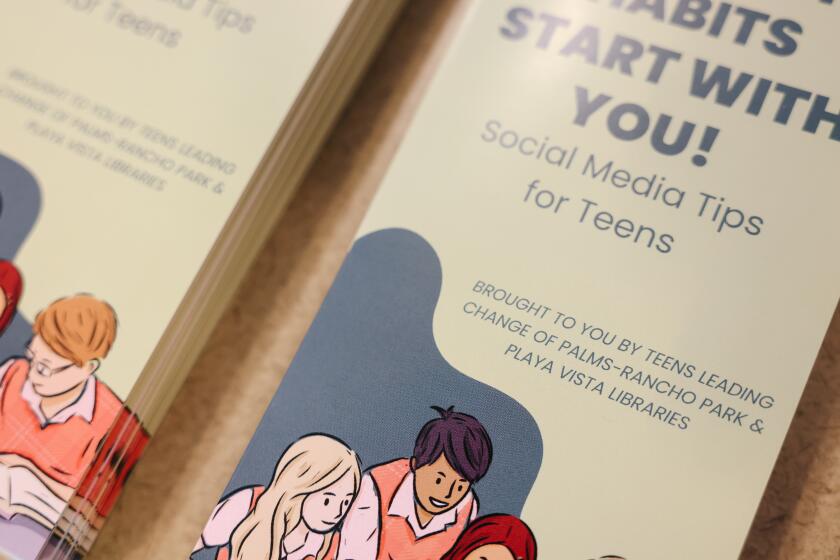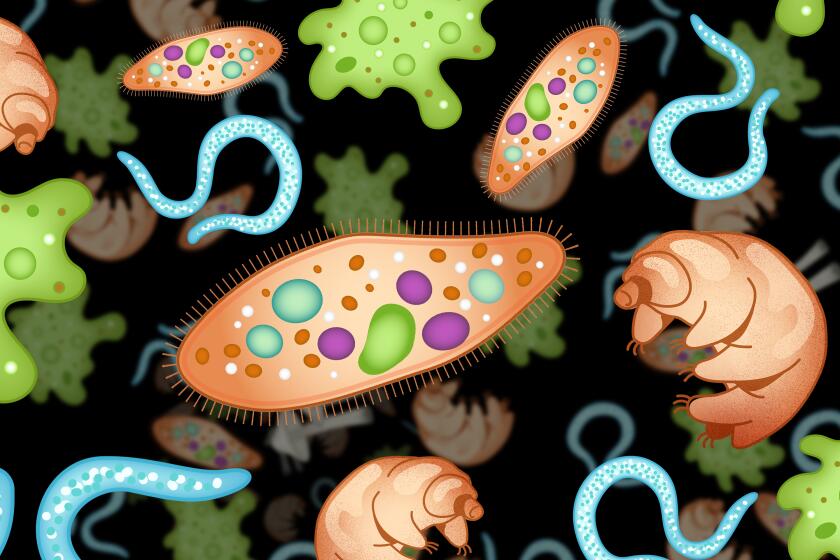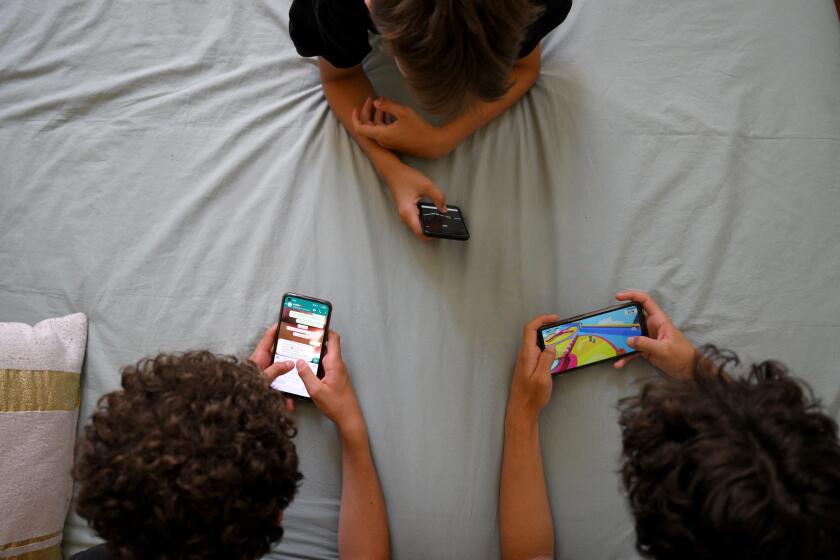Science doesn’t yet support broad restrictions on teens’ access to social media, experts say

- Share via
To understand the path forward in regulating social media, it’s helpful to look to a transformative technology from the previous century: the car.
A car is an essential tool for getting to places we want and need to go. It’s also an exceptionally powerful one that can be dangerous if handled irresponsibly.
We require education and training for people who want to drive. We insist that companies build in safety features, which are updated over time as research and technology advance.
And when young people come of age and want to get behind the wheel, “we would never dream of allowing them near a car where we didn’t have safety standards for the vehicles and where we didn’t have education for the adolescents,” said Dr. Sandro Galea, a Boston University physician and epidemiologist.
“But if you think about it,” he said, “that’s exactly what we do with social media.”
In a report released Wednesday by the National Academies of Sciences, Engineering and Medicine, Galea and 10 other researchers lay out a plan for what society might do instead to improve adolescents’ interactions with social media.
The U.S. surgeon general says there isn’t enough evidence to show that social media is safe for young people. He called on tech companies and caregivers ‘to protect kids now.’
The report acknowledges the distressing rise in depression, suicide and poor mental health among U.S. adolescents, as well as the corresponding growth in their social media use.
Correlation, however, is not the same as causation. After a thorough review of the available research on the subject, the researchers said they were unable to find evidence to support at this time broad restrictions or bans on young people’s access to the vast array of tools and platforms that can be called social media.
“The temptation to draw causal inference and to call for rapid action around social media is strong,” the report says. “And yet, in careful deliberation and review of the published literature, the committee arrived at more measured conclusions.”
There is strong evidence to conclude that certain features of social media can be harmful to young users, the study team wrote. Algorithms designed to maximize engagement can drive users’ attention toward harmful content and disinformation, warping their sense of reality. Time spent on devices can come at the direct expense of exercise, study and sleep.
Social media also create opportunities for exploitation and harassment that simply didn’t exist before vast swaths of the population were connected by pocket-size computers.
But the social media category encompasses many different types of online discussion and play, and many of these offer real benefit to the young people who use them, the authors wrote — particularly teenagers who feel marginalized elsewhere.
Rather than back the kind of “broad-stroke bans that have been proposed by other entities in recent years,” the committee determined that “a judicious approach to protect youth mental health is warranted,” Galea wrote in the report’s introduction.
Adolescents who have dealt with cyberbullying and body dysmorphia due to their time spent online offer tips for their peers on how to navigate these spaces.
About 95% of U.S. teens ages 13 to 17 own a smartphone, and 97% access the internet daily, according to a 2022 survey by the Pew Research Center. And while teen social media use is a hot-button issue in lawmaking chambers, schools and homes, the term can refer to a variety of activities — from scrolling through photos to gaming to group texting with friends — that each come with their own benefits and drawbacks.
Research and media reports on teens and smartphones often fail to distinguish among these activities, making it difficult to discern which specific features and behaviors may cause harm, the authors of the National Academies report wrote.
It’s also an incredibly slippery subject. Social media and their audiences evolve quickly. By the time a longitudinal study on usage of any particular app has finished, its subjects may well have shifted their attentions to a new platform that didn’t even exist at the time the study started.
As a result, researchers and policymakers are constantly “trying to play catch up to the ever evolving changes in platforms and adolescent use patterns,” Linda Charmaraman, director of the Youth, Media & Wellbeing Research Lab at the Wellesley Centers for Women, who was not involved with the National Academies report, said in an email. “I agree that before we implement any sweeping limits on youth’s access to social media, we need to have more conclusive evidence that disentangles adolescent use from all other age groups.”
The authors of the report called for more research on the causal links between specific elements of social media and mental health. Given that “there are only so many questions that can be answered without the platforms’ explicit cooperation,” the authors also called for tech companies to make their data available to researchers, and for Congress to pass laws requiring them to do so.
More emojis of plants, mollusks, flatworms, fungi and microorganisms could help spark new conversations about conservation and biodiversity, a new study argues.
That would certainly help, said Dr. Jason Nagata, an associate professor of pediatrics at UC San Francisco who was not involved in the report.
In the meantime, families, schools and lawmakers still have to craft their own positions on a powerful and unavoidable presence in children’s lives.
The science doesn’t support broad societywide bans on social media, but none of the report’s recommendations preclude individual families from setting rules for their own child’s use.
“The reality is,” Nagata said, “that adolescents, parents, educators and policymakers need to make decisions about adolescent social media use now even in the absence of the highest quality evidence.”
Some adolescent mental health experts challenged the conclusion that more research is needed before moving forward with policy.
“There should be some restrictions on the content that adolescents see. I’m a little concerned about waiting until the research and science comes out fully,” said Dr. April Thames, a professor of psychiatry at UCLA. “We know about adolescent brain development. It’s highly vulnerable to the effects of social media. We need to work with what we’ve got.”
The older children are when they get their first smartphone, the better their mental health later in life. That’s little consolation to teens feeling left out when all their friends are connected.
San Diego State psychologist Jean Twenge has been following trends in adolescent mental health for decades. In the early 2010s, she noticed a sharp uptick in the percentages of young people citing feelings of loneliness, isolation and lack of purpose.
While rates of depression tend to rise during economic downturns, these trends ran counter to a strengthening economy. Over time, as she investigated rates of technology change and adoption, a conclusion took shape.
“The rise of these technologies was by far the largest change in teens’ lives after 2012,” Twenge said this week during a seminar sponsored by the USC Center for Health Journalism. “It was something that had an impact on their day-to-day lives, for hours and hours a day over this time. Nothing else really fits the pattern.”
She said she presented her findings to the National Academies committee. “As far as I know, they chose to ignore all of it,” she said Wednesday after paging through the report.
“People will say, ‘Well, not every kid who is a heavy social media user is depressed.’ Absolutely true. Definitely true. Can’t dispute that,” Twenge said. “However, if you tell your average parent that if your kid is a heavy social media user they are twice as likely to be depressed, that makes a difference.”











